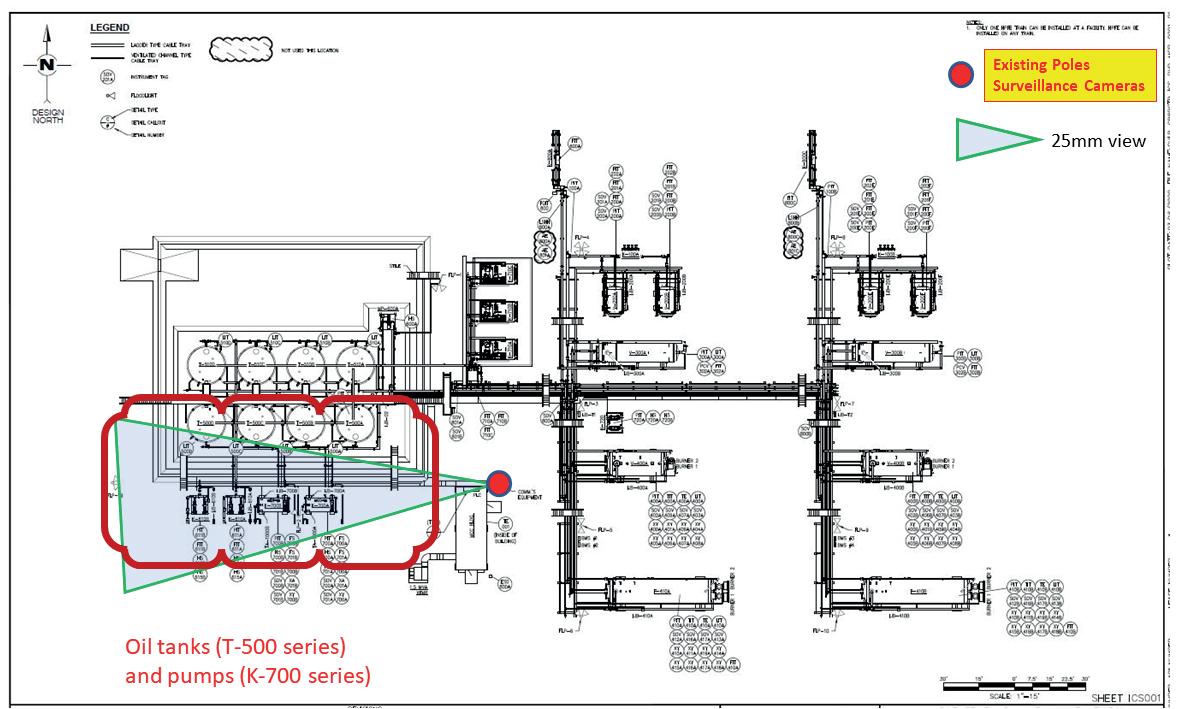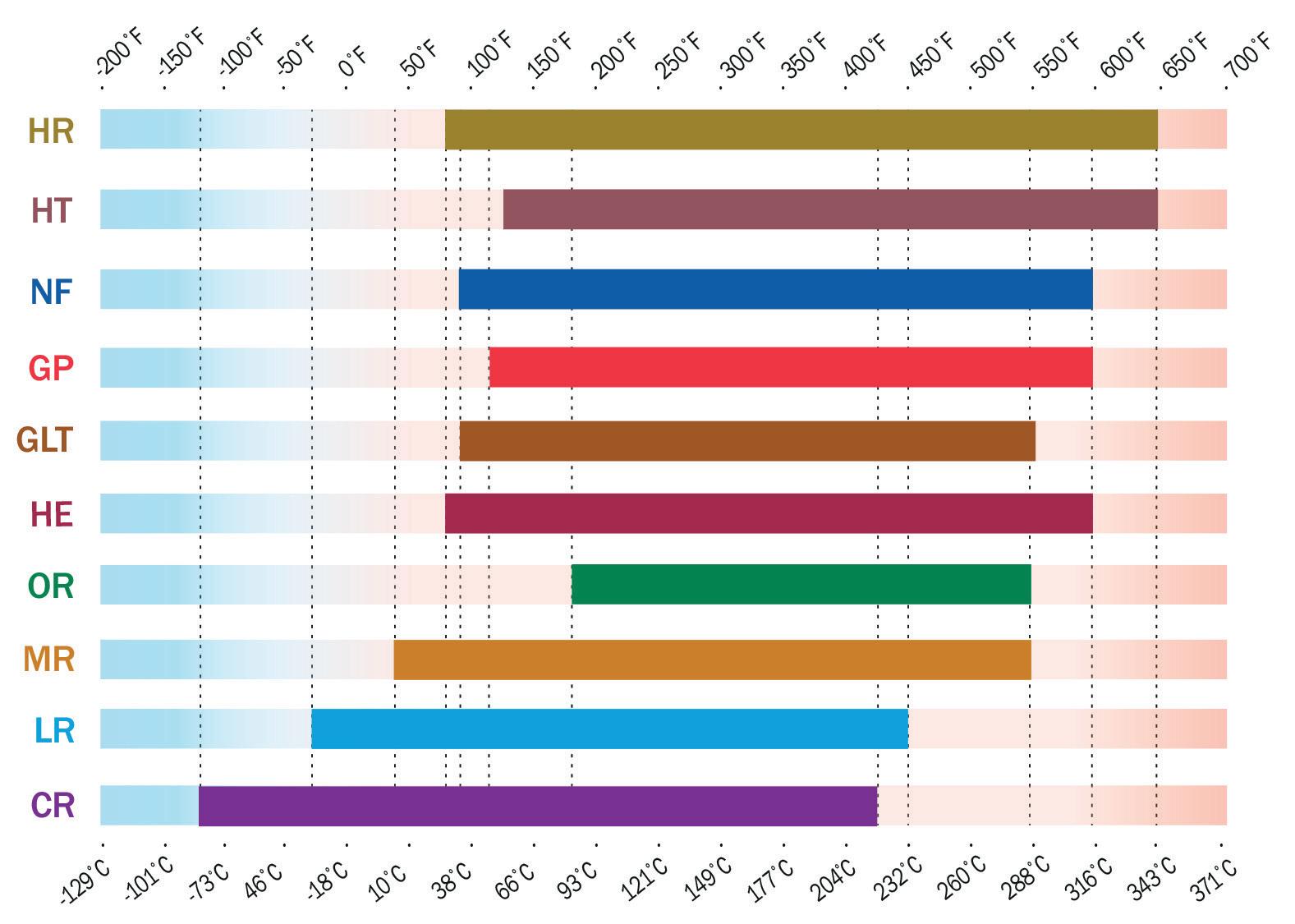
12 minute read
Bolstering fire safety
Figure 2. The IntelliView DCAM consists of a thermal sensor, a colour sensor, and built-in AI engine. It is designed to automatically detect and sound an alarm on pre-defined events. Thermal and colour images are rendered side-by-side, with analytic software tracking displayed to serve as visual aid (left), as shown in the screen grab of a simulated leak at commissioning.

Figure 3. Installing AI cameras in high-priority regions is a cost-effective way to enhance monitoring capabilities. They work in conjunction with other methods, closing close coverage gaps and adding a layer of protection.
The gains of automating with intelligent thermal cameras
Intelligent vision technologies can contribute valuably to field monitoring and hold the key to delivering many of the benefits and advantages of automation, across many levels.
Greater, continuous level of awareness
AI replaces hours and hours of manual screen viewing, freeing up valuable time that workers can utilise for more critical tasks, such as maintenance and repair. Potentially disruptive events that take place during the day or night can be detected without human involvement. Additionally, with the combined capabilities of IIoT and wireless infrastructures, hundreds of enterprise-wide distributed cameras can be streamlined into a single platform, rendering the management of large-scale and complex monitoring needs effortless.
Improved detection
With intelligent thermal imaging, visibility and detection of objects in the dark is significantly improved even without an illumination source. The technology can also see early-stage liquid and wet hydrocarbon releases that are approximately 0.4 l/s in size, which can be up to 40 times smaller than what is detectable through computational pipeline monitoring methods. Faster response
An alarm that is pre-validated onsite and accompanied by visual evidence removes the guesswork, allowing operators to confirm, pinpoint the location of the anomaly, and take informed and appropriate action at speed. This could be remotely shutting down the affected area of operations and dispatching a remediation crew instead of commissioning manpower or a drone scan first. AI cameras can also be linked to a control system (e.g. SCADA) to further reduce effort and response times. A midstream company in Colorado, US, uses vision-based leak detection technology in conjunction with a secondary sensor to facilitate autonomous shutdown.
Lower HSE impacts
By having the ability to respond immediately to leaks, fire, theft, or vandalism, the environmental footprint of operations, along with regulatory scrutiny and reputation damage, can be mitigated. Having remote video access to the field, either via alarm videos or recorded videos, provides a safe means for first responders and maintenance staff to conduct situational assessments. Additionally, unaware workers onsite can be warned very early on of the location and status of emerging dangers.
Cost savings
An onshore spill clean-up bill can amount to anywhere between US$300 000 – US$15 million. One example of this is the Buncefield Oil Depot fire that cost Total a little over US$1 billion (£750 million) in damages from tank overspill. Through timely notifications and actionable data, intelligent cameras can help lessen or avoid these financial liabilities, as well as product loss and production downtime. Operational savings can also be achieved by replacing manual video monitoring and in-person trips. Up to 50% reduction in site visit related wages were observed by a global energy company after installing AI leak detection cameras. Furthermore, adding more cameras to a site and more sites to the system will have minimal impact on operating expenses, and the use
of available structures, such as for mounting, will reduce installation costs.
Industry applications for AI cameras
Many operations of an oil and gas depot can be automated using AI cameras.
Security monitoring
AI cameras have been extensively used to protect assets from unwelcomed guests, including intruders (humans and animals), thieves, arsonists and vandals. An oil and gas company was able to detect theft using a leak detection camera that was running 24 hr/d at the site. The alarm contributed to the identification and prosecution of the individual involved.

Figure 4. An intelligent vision solution plan for a crude oil terminal of a global midstream operator shows a single 25 mm camera providing sufficient coverage of the areas of interest.
Leak detection
The identification of petroleum product escapees, such as oil, liquids, and gases, is also one of the primary uses for AI cameras in the industry. A global midstream energy operator has installed an IntelliView DCAM system at two sites to survey water tanks (T-500 series) and pumps (K-700 series) for crude oil fugitives. One location is using a 25 mm lens for long range coverage, and the other uses a 13 mm lens to achieve wider field of view at a shorter distance.
Tank level monitoring
Thermal imagers can visualise tank content by detecting the temperature difference between the filled region and the empty region. With AI, product levels can be autonomously monitored to ensure that operations are moving efficiently and that potential overflows are identified before causing a spill.
Flame/fire ignition monitoring
Due to the chemical composition and characteristics of the products handled, tanks and terminals are high flammable and explosion risk zones. Deploying AI cameras for fire, flame and/or temperature detection in tandem with other sensors, whether visual or non-visual, can provide a more reliable early warning. For highly hazardous environments, explosion-proof rated cameras are recommended. They can withstand a significant degree of fire impact and will be able to provide visual data in a safe manner, both during and after an incident, which can assist with investigation and reporting.
Workforce and safety monitoring
Employing AI cameras to monitor personnel, contractors and vehicles onsite provides managers with visual data that can be used to confirm work hour inconsistencies, improve scheduling, and identify unauthorised presences. Accessing live feeds can also assist in determining whether an asset or facility is safe to approach after an incident, while recorded footage may provide answers to OHS-related concerns.
Remote surveys
Asset and equipment inspections can be conducted from any offsite location (e.g. office, home, airport) at any time of the day, through internet-enabled devices. This flexibility not only offers substantial time and cost savings through reduction of in-person surveys, but also allows operators to safely gain field insights even in the presence of risky site conditions, staff shortage, and environmental deterrents.
Conclusion
With visual verification acting as the foundation of any executive decision making and action, AI cameras are expected to be a major driving force in the future of terminal automation. New applications and platforms (e.g. robotics, predictive tools), growing demands for safety and efficiency, and more stringent regulations will continue to provide the impetus for technology creation and betterment, propelling video AI companies such as IntelliView Technologies to continue moving forward, pushing the limits of their innovations.
References
1. BLANCETT, J., POCKER, S., and RANJAN, A., 'Automating the
Petroleum Industry, from Wells to Wheels', Cognizant 20-20
Insights, Cognizant, (2019), https://www.cognizant.com/ whitepapers/automating-the-petroleum-industry-from-wellsto-wheels-codex4114.pdf 2. McKinsey & Company, 'AI, Jobs and Workforce Automation', (May 2017), https://www.cloudave.com/57719/mckinsey-aijobs-workforce-automation/
COVER STORY




Edward Cass, Paratherm, USA, explains how the risk of fire in thermal fluid systems can be minimised.
Thermal fluid systems have been operating safely for many decades, across a wide range of industries. However, it is impossible to eliminate all risk in these systems as the necessary ingredients for fire – fuel, air and an ignition source – are all present by design. While the established safety record of thermal fluid systems is a testament to proper system design and attentive maintenance practices, not all systems are designed and operated with best practices in mind. The evolution of remote sensing technologies and the Internet of Things (IoT) has helped to make thermal fluid systems even safer in modern times, but there remain several safety considerations for both new and existing systems that designers, engineers, original equipment manufacturers (OEMs) and operators should be aware of. Fire risk in thermal fluid systems can be minimised by understanding the causes of thermal fluid fires and mitigating those causes by observing key installation practices for design, installation, operation and maintenance of the systems.

Causes of fires in thermal fluid systems
Fluid and vapour leaks are the most obvious causes of fires in heat transfer systems. Small volume leaks around flanges, valve stems, etc., generally do not present any significant safety hazard. Leaked fluid usually oxidises, which creates smoke and eventually black stains. Nonetheless, small leaks can become hazardous if left unaddressed. No leak, small or large, should ever be ignored.
Catastrophic failure of mechanical components such as pump seals, rotary unions or expansion joints can quickly lead to dangerous conditions. High volume leaks create more ignitable vapour, and more material that can find an ignition source in the immediate surroundings.
Explosive discharges may occur from rapid pressurisation of the system. This scenario is commonly experienced when hot oil and water find each other. Rapid vaporisation of liquid water to steam may lift a pressure relief valve, and the steam may atomise oil as it exits. Catch tanks containing water have been known to create this scenario.
Component failures such as pump couplings, malfunctioning bypass valves and plugged Y-strainers can reduce or interrupt the oil flow rate through the heater. Safety circuits are standard for monitoring temperatures and pressures throughout the system. However, if safety interlocks are bypassed, or probes become fouled or unresponsive, a runaway situation can occur, creating conditions for superheated fluid and possible system rupture.
Cracks in heater tubes may form when damaged or worn burners cause flame impingement on the tubes, resulting in localised hot spots that can lead to coke formation. The coke acts as an insulative layer resulting in uneven thermal expansion and fractures that leak oil into the combustion chamber. The oil then adds to the fuel value while the heater is running, but can pool in the chamber when the heater is off, and cause a major fire at start-up.
Start smart: design and installation tips
Heat transfer systems should always be designed and/or reviewed by qualified engineers that are familiar with their construction and operation. There are several industrial standards that can be referenced for guidance in the
construction of heat transfer systems. In addition to these standards and OEM recommendations, the next section of this article presents a few tips and best practices to improve the long-term safety and reliability of thermal fluid systems.
Putting it together
Piping networks should be designed for combustible fluid service – sized and installed to provide the required flow rate with an economical pressure drop. Standard construction material is schedule 40 seamless carbon steel pipe. All connections should be welded except where breakable connections are necessary, such as access/maintenance points around valves, pumps and equipment. Class 150 or 300 raised-face flanged connections are recommended, depending on the operating pressures/temperatures. To ensure proper gasket seating, raised-face flanges must have a proper surface finish.
Correct flange alignment is equally critical. Misalignment can result in overstressing one side of a flange while leaving the other without sufficient compression to seal the gasket. Once a flange pair is properly aligned, the lubricated fasteners must be incrementally tightened in a star pattern to maintain proper alignment and even compression. Applying adequate initial preload to the flanged connection will minimise the risk of leaks after system start-up. Once the system has started up, it is wise to ensure that flange bolts are checked for proper torque at normal operating temperature.
Flange gaskets are typically spiral-wound stainless or flexible graphite. Spiral-wound and grooved-metal gasket designs resist blowouts from sudden over-pressurisation, and are constructed for leak-free operation.
Threaded connections should always be avoided where possible. In lieu of threaded connections for instrument gauges/sensors, bendable tubing with compression fittings has been found to be a satisfactory alternative. Where threaded connections are necessary, the use of schedule 80 carbon steel is recommended, with pipe diameters not to exceed 1.5 in. (38 mm). Threaded connections should be joined using a thread sealant that is compatible with the thermal fluid and the operating conditions.
Expansion joints should be utilised to relieve stresses from thermal expansion of fixed structures (eg. circulation pumps). Such joints may include steel expansion loops, or ‘U’ bends, bellows-type expansion joints, or high temperature flexible metal hoses. Flexible expansion joints must be supported on both ends and installed in such a way that they move axially.
Valves tend to be a major source of leaks in thermal fluid systems. Leaks can be minimised by utilising valves with metal bellows (as the primary seal) in combination with high temperature graphite packing (as a secondary seal). In general, globe, gate, and rising-stem ball valves are the preferred choices for thermal fluid systems. Since valve stems are potential leak sources, they should be installed with the stem in a horizontal position if possible (provided that the valve manufacturer does not advise against this orientation). Should a leak occur in this configuration, the fluid will drip away from the valve rather than down into any insulation around the valve.
Keep the air moving
Where possible, heat transfer systems should be installed in open structures. For closed structures, explosion relief construction and adequate ventilation are critical safety considerations. High air exchange rates help to rapidly cool leaked vapour to smoke, and cool leaked liquid to prevent further vaporisation. The general rule of thumb is for fresh air to enter low and exhaust high, maximising contact with any leaking material. There should be air movement around critical areas such as pumps. If the heater room temperature is more than 25°F (13°C) higher than the outside temperature, there may not be enough air flow.
Figure 1. Fluid selection is critical to continuous performance, safety and reliability of the heat transfer system. It is important to specify a fluid that comfortably covers the entire operating range, including start-up conditions. Prevent wicking potential of insulation
It is well understood that a combustible fluid can ignite at temperatures below its published autoignition temperature, if spread in a thin film. The high surface area present in many types of insulation can promote this phenomenon when soaked with a thermal fluid. Open cell insulation, such as mineral fibre, can wick, leaking heat transfer fluid into its porous structure. The wicked fluid proceeds to oxidise, which can raise the temperature of the insulation above the fluid’s autoignition temperature.
Foamed glass insulation is the standard recommended insulating material because it cannot absorb oil. Leaked oil will pool following the path of least resistance. Weep holes are sometimes drilled through the insulation to prevent excessive accumulation.










